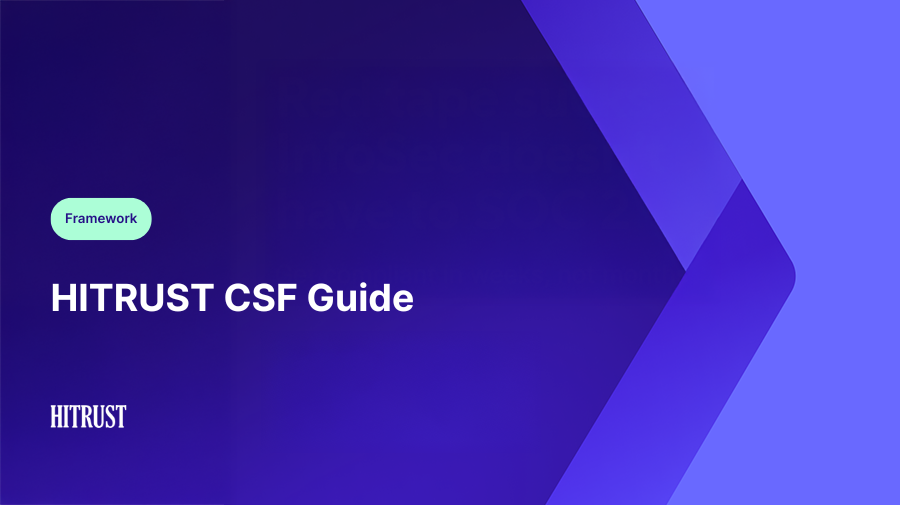
HITRUST CSF Guide
For healthcare and life-sciences organizations handling sensitive data, trust is fundamental to a successful business. HITRUST CSF (Common Security Framework) has emerged as one of the most comprehensive and certifiable ways to demonstrate that trust.
This guide breaks down what HITRUST CSF is, how it differs from HIPAA, what the certification levels mean, and how to streamline the path to certification with automation.
What is HITRUST CSF?
The Health Information Trust Alliance (HITRUST) created the Common Security Framework (CSF) to unify and simplify compliance across multiple regulations and standards.
Rather than focusing on one region or industry, HITRUST maps requirements from dozens of frameworks (HIPAA, ISO 27001, NIST CSF, PCI DSS, and GDPR) into a single integrated control set. The result: a certifiable standard that offers consistent assurance for security, privacy, and regulatory compliance.
HITRUST vs HIPAA
While HIPAA (the Health Insurance Portability and Accountability Act) defines legal requirements for protecting patient health information in the US, it does not prescribe how to prove compliance.
HITRUST CSF provides that missing structure: a certifiable, measurable system for implementing and validating HIPAA-aligned controls.
In short: HIPAA sets the rules; HITRUST CSF proves you’re meeting (and exceeding) them.
HITRUST Levels: i1, r2, and e1
HITRUST certification now supports three assurance levels, designed to meet organisations where they are:
The HITRUST certification process
Achieving certification typically follows six stages:
Define Scope & Objectives: Identify applicable systems, data types, and regulatory mappings.
Readiness Assessment: Perform a self-evaluation or gap analysis to align existing controls with HITRUST CSF.
Implement Required Controls: Update policies, security configurations, and evidence collection methods.
Validated Assessment: A certified HITRUST Assessor tests controls and compiles documentation.
Quality Review & Remediation: HITRUST reviews findings, and the organisation addresses any gaps.
Certification & Maintenance: Certification is issued for up to two years, with an interim review at twelve months.
Want a deeper walkthrough of HITRUST requirements, control mappings, and audit preparation? Check out our full HITRUST CSF Implementation Checklist below:
Benefits of HITRUST certification
Unified Compliance: Replace multiple audits (HIPAA, SOC 2, ISO 27001, NIST) with a single integrated framework that maps to all.
Market Trust & Preferred Vendor Status: Major healthcare payers, insurers, and life-sciences networks increasingly require HITRUST certification as proof of due diligence.
Operational Efficiency: Mapped controls reduce duplication. Automation tools like Complyance’s AI Agents automatically gather, validate, and map evidence, shortening audit prep time by up to 70 %.
Continuous Improvement: HITRUST’s maturity scoring encourages measurable progress from ad-hoc practices to optimised risk management.
Competitive Advantage: Certification signals enterprise-grade governance, enabling faster onboarding with partners and new clients.
With automation through Complyance’s Agentic AI, teams can remove manual friction, align overlapping frameworks, and maintain readiness year-round, turning compliance from a periodic project into a continuous advantage.
Ready to simplify HITRUST certification? {Book a demo} to see how Complyance automates evidence, streamlines assessments, and keeps you audit-ready year-round.
FAQs
How long does HITRUST certification take? Between 4 and 12 months, depending on readiness, control scope, and chosen assurance level (i1 vs r2).
Does HITRUST replace SOC 2 or ISO 27001? No, it builds on them. HITRUST maps to both, so evidence can serve multiple frameworks simultaneously.
What are common pitfalls? Manual evidence tracking, unclear ownership, and underestimating the remediation phase. Automated evidence mapping prevents rework.
Who issues HITRUST certificates? Only accredited HITRUST Assessors. Complyance integrates with assessor workflows to provide validated, auditable evidence packages.
How often is recertification required? Every two years, with an interim review at 12 months to maintain status.




